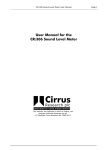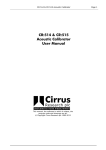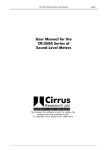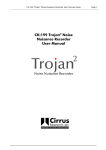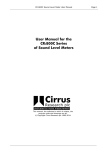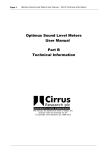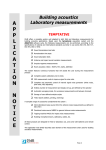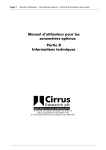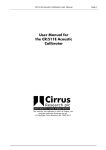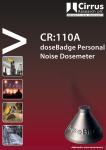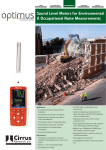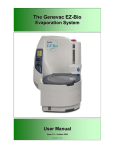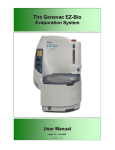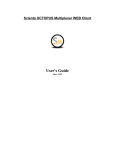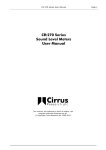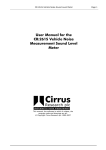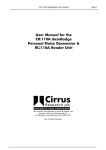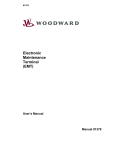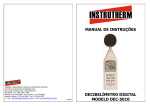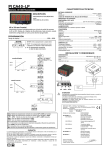Download User manual for the CR:700B Series (CR:701B, CR:704B, CR:703B)
Transcript
CR:700B Series User Manual CR:700B Series User Manual This manual, the software to which it relates, the program code and drawings are all: © Copyright Cirrus Research plc 1989-2002 CR:700B Series User Manual Page 2 The content of this manual, any illustrations, technical information and descriptions within this document were correct at the time of going to print. Cirrus Research plc reserves the right to make any changes neccessary, without notice, in line with the policy of continuing product developement and improvement. No part of this publication may be duplicated, reprinted, stored in a data processing system or transmitted by electronic, mechanical, photographic or other means, or recorded, translated, edited, abridged or expanded without the prior written consent of Cirrus Research plc. No liability is accepted for any inaccuracies or omissions in this manual, although due care has been taken to ensure that is it complete and accurate as possible. Accessories supplied by Cirrus Research plc have been designed for use with the instrumentation manufactured by Cirrus Research plc. No responsibility is accepted for damage caused by the use of any other parts or accessories. Produced by Cirrus Research plc, Acoustic House, Bridlington Road, Hunmanby, North Yorkshire, YO14 0PH. © Copyright Cirrus Research plc 2002 Reference Number 01/09/700B/98 Document Printing Date 21 January 2002 CR:700B Series User Manual Page 3 1. Introduction 1.1. New Functions Page 5 Page 5 2. Using the Instrument Page 6 3. Quick Start Page 6 4. Switching On 4.1. Configuration at Switch On Page 8 Page 8 5. Resetting the Instrument and Clearing the Memory 5.1. Short Leq Data 5.2. Internal Reset Button Page 8 Page 8 Page 9 6. Setting the Clock Page 9 7. Calibrating the Instrument 7.1. Calibration Check Page 10 Page 11 8. Measurement Range 8.1. Checking the Measurement Range 8.2. Changing Range during Measurements Page 12 Page 12 Page 12 9. Pausing Measurements Page 12 10. Measuring Data 10.1. Memory Capacity 10.2. Starting Events 10.3. Storing Short Leq Data Page 15 Page 15 Page 15 Page 16 11. Ending a Measurement 11.1. Events 11.2. Short Leq Data Page 17 Page 17 Page 17 12. Viewing Stored Events 12.1. Increment & Decrement Event Page 17 Page 17 13. Switching Off Page 18 14. Memory Backup Page 18 15. Downloading Data 15.1. Connecting the CR:700B Page 18 Page 18 16. Calibration 16.1. Recommended Calibrators 16.2. Procedure 16.3. Calibration Check Page 19 Page 19 Page 20 Page 20 17. Replacing the Battery. Page 21 18. Instrument Functions. Page 22 CR:700B Series User Manual 18.1. Keypad 18.2. Display Functions 18.3. Available Parameters 18.4. Printout Information. 18.5. Automatic Events. 18.6. Integrators. 18.7. Exceedence Levels or Ln values. Page 4 Page 22 Page 22 Page 24 Page 26 Page 26 Page 26 Page 27 19. Trouble Shooting Page 28 20. Rating Plate Information. Page 29 21. Specification. Page 32 23. Guarantee Page 34 24. Cirrus Research Offices Page 34 CR:700B Series User Manual Page 5 1. Introduction This manual refers to the CR:700B series of data logging Sound Level Meters and data logging dosemeters. The range of instruments in the CR:700B series are: • CR:701B Type 2 Data Logging Personal Sound Exposure Meter (Dosemeter). • CR:704B Type 2 Data Logging Sound Level Meter. • CR:703B Type 1 Precision Data Logging Sound Level Meter. These instruments replace the previous CR:700 series of instruments. In particular, the CR:702 has been replaced by the CR:704B which has two measurement ranges rather than the single range of the CR:702. This manual does not refer to the previous range of CR:700 series of instruments, although most of the functions described in this manual are available from the previous versions. 1.1. New Functions The additions to the CR:700B instruments are: • Clock set available directly from keypad • Short Leq data acquisition started with the first Event measurement • Pause key added • 700Setup for Windows supplied as standard The CR:700B series of instruments are supplied with the updated version of 700Setup, now called 700Setup for Windows. This program is compatible with MSWindows (versions 3.1, 3.11 and 95), and replaces the W700Read software previously supplied as standard with the CR:700 series. It also replaces the previous versions of 700Setup and 700Read for MS-DOS. CR:700B Series User Manual Page 6 2. Using the Instrument The CR:700B Instruments can be used to measure many different noise parameters depending upon the configuration of the instrument. The following chapters give details of the steps required to use the CR:700B Instrument with the standard factory default configurations. It is important to check that the battery used within the instrument has sufficient power to complete the measurements that are to be carried out. The display will indicate low battery power, at which point the battery should be changed. See section 21 for details of changing the battery, and section 18.2 for details of display functions. 3. Quick Start The following procedure can be followed to begin a measurement. Please refer to the following sections for further details of each part of the procedure. In particular, refer to Section 5 for details of clearing the memory of the instrument. Action See Section Switch On the Instrument Reset the Instrument & Clear the Memory Check the Clock Calibrate the Instrument Check Measurement Range Start a measurement Event Short Leq End Measurement Switch Off the Instrument Download Data 4 5 6 7 8 10.2 10.3 11 13 15 The diagram below shows the steps that should be followed to start a measurement. CR:700B Series User Manual Power On Check Battery Reset Instrument Check Clock Calibrate Check Range Start Event #1 Start Short Leq Store Repeat Stop Event Second Calibration Power Off Download Data Quick Start Flowchart Page 7 CR:700B Series User Manual Page 8 4. Switching On To switch on the instrument, press the On key. The CR:700B will power on and the display will show all the characters available. Once the power is stable, the display will revert to showing the current Sound Level or SPL(F) in dB(A). The instrument can now be calibrated and measurements made. If the instrument does not power up when the On key is pressed, check that there is a battery connected and that the battery has sufficient power. See section 19 for Trouble Shooting if problems persist. 4.1. Configuration at Switch On When the instrument is switched on, it will revert to its default settings. This applies to the measurement range and the default display of Sound Level. The CR:701B Data Logging Dosemeter is a single range instrument, and therefore the selection of the measurement range does not apply. However, for both the CR:703B and CR:704B dual range instruments, the power on configuration is the High range. This range is selected to allow the instruments to be calibrated at the preferred level of 93.7dB. 5. Resetting the Instrument and Clearing the Memory Before a new set of Event measurements can be started, or a new block of Short Leq data stored, the instrument should be reset and then calibrated. Please note that clearing the memory will destroy all previous data and should be done with care. The memory of the CR:700B instruments is powered by both the main battery and an on-board backup supply which allows the contents to be kept over long period of time. Before resetting the instrument, the information contained in the memory should be downloaded to a suitable computer using the supplied 700Setup for Windows software. See section 15 for details of Downloading data from the CR:700B. 5.1. Short Leq Data The CR:700B instrument can store a single sequence of short Leq time history data . The storage of this data begins with the start of the first Event and ends when the instrument is switched off. Therefore once this memory has been used, the data must be downloaded and the memory cleared (Reset) before further data can be stored. However, Event measurements can be made and the data will be simply stored in the next available memory location. Clearing the memory will also destroy all of the Event data held in the instrument as well as the calibration information. CR:700B Series User Manual Page 9 To Reset the instrument and clear the memory, press and hold the Reset key for 5 seconds. The display will show a countdown from 5 to 0 and the instrument will then reset. During the reset period, all of the characters of the display will be shown. After reset, the display will revert to Sound Level. When the instrument is reset, the unit will reload its default configuration from EPROM in to the operating system. This allows the instrument to be rebooted if any problems occur for example when attempting to reprogram the instrument with a new configuration. 5.2. Internal Reset Button In addition to resetting the instrument using the keypad, a master reset button is available if an error occurs, such as the keypad locking. This master reset button is located next to the RS232 socket inside the battery compartment as shown below: RS232 Socket Battery Reset Button CR:700B Battery & RS232 Connections Pressing the reset button does not destroy the internal memory of the instrument, unlike pressing the Reset key. 6. Setting the Clock The CR:700B series of instruments have an internal real time clock and calendar which is used to time and date stamp all operations carried out. These include calibration, reset and Event and Short Leq measurements. It is very important that the clock is set correctly before measurements are taken and before the instrument is calibrated. To check the status of the internal clock, press the Clock key. The layout of the Clock key on the keypad is shown below. See section 18 for further information regarding keypad functions. This will display the current time of the instrument clock. If this time is correct, then the instrument can be calibrated and measurements made. If, however, the clock does not show the correct time, hold the clock key for 5 seconds to enter the clock set procedure. Page 10 CR:700B Series User Manual +5 +1 Next Set Clock Clock key positions The keys shown above are used to set the clock. Once the clock set procedure has been started by pressing the clock key for 5 seconds, the functions shown at the top of each key become active. The +5 and +1 keys are used to advance the current parameter, and the Next key used to step to the next parameter. The parameters to be set are: Current Time (Hours) Current Time (Minutes) Current Month Current Date Current Year Once the Year has been entered, pressing the Next key will exit from the procedure and the clock will be set. 7. Calibrating the Instrument It is essential that the CR:700B Instruments are calibrated before use to ensure the accuracy of the measurements. The CR:700B instruments are fitted with ½" microphone capsules. The instruments therefore require an Acoustic Calibrator that can be used with this type of microphone capsule. The Cirrus Research CR:513A or CR:512 Acoustic Calibrators are the recommended units for use with the CR:700B Instruments. To Calibrate the instrument, carefully insert the microphone capsule into the cavity provided by the Acoustic Calibrator. Ensure that the capsule is correctly seated in the cavity. Switch on the Calibrator and select the setting of 94dB. The CR:700B Series are preset to accept a calibration level of 94dB. Press the SPL key and allow the level to settle for 5 seconds. Once the level has stabilised, press the Cal key. The instrument will now calibrate unless an error occurs. See section 19 for Trouble Shooting. CR:700B Series User Manual Page 11 The microphones fitted to the CR:700B instruments when used with any of the Cirrus Research plc CR:510 Series of Acoustic Calibrators require a correction of 0.3dB. Therefore the instruments will calibrate to 93.7dB, rather than 94.0dB. Once the display shows 93.7dB, the calibration process has been completed and the instrument may be used. For further details regarding calibration, refer to section 16. Also refer to the manual supplied with the Acoustic Calibrator being used for details any of calibration corrections that may be required. 7.1. Calibration Check Once the measurements have been completed, a calibration check can be carried out to ensure that the instrument has not drifted during operation. This calibration check is stored in the instrument and is displayed when the data is downloaded. To carry out the calibration check, follow the procedure detailed above. Once the calibration check is completed, the display will revert to the current Sound Level. CR:700B Series User Manual Page 12 8. Measurement Range The CR:703B and CR:704B Instruments have two measurement ranges. This allows a wide range of noise levels to be measured. When the instruments are switched on or are reset, the range is set to the default. This is the High range as standard in both instruments. To toggle the measurement range from high to low and vice versa, press and release the On/Hi-Lo key. The display will show the new range and then revert to Sound Level. 8.1. Checking the Measurement Range To check the current range, press and release the Off/Range key. This will show the current range, either HI or LO indicating the High or Low measurement ranges. 8.2. Changing Range during Measurements If the measurement range is changed during an Event, the measurement will be stopped. If the instrument is storing Short Leq data when the range is changed, the storage will not be affected and will continue until the instrument is either reset or switched off. 9. Pausing Measurements The Pause key function has been added to those available from the CR:700B Series. The Pause key acts as a data inhibit function and will affect the instrument in different ways according to the operating status of the instrument when the key is pressed. Pause mode is entered by pressing the Pause key, and is released by pressing it again. As an example, shown below are three different cases of the Pause Mode. These are: Example 1 Pause during an Event. If the Pause Key is pressed during an Event, the noise data occuring during the Pause will not be included in the information for the Event. Also, the run time of the Event will be adjusted accordingly to remove the time in Pause mode. Example 2 Pause during subsequent Events. The Pause key is pressed during an Event and then the Event is stopped with the instrument still in Pause Mode. As above, any data occurring when the instrument is in Pause mode will be removed from the calculated values stored for the Event. A new Event is started with the instrument still in Pause mode by pressing the Run Key. The Event will start, but data will be inhibited until the Pause key is pressed again to end the Pause mode. Example 3 Pause during Automatic Events. CR:700B Series User Manual Page 13 When the instrument is programmed to perform automatic Events, the Pause key will not affect the starting and stopping of the Events. However, as in the two other examples above, any data occurring during the Pause mode will be removed from the calculated values. The duration of the Events will also be adjusted according to the amount of time the instrument has been in Pause mode during the Event. See Section 22 for the information shown on the display when the instrument is in Pause mode. The diagram below shows how the Pause key affects the data during an Event as described in the examples above. CR:700B Series User Manual Page 14 Instrument Paused Data Inhibited Event Running Time Example 1 - Pause Key Pressed During Single Event Instrument Paused Data Inhibited Event Running Event Running Time Example 2 - Pause Key Pressed During Manual Events Instrument Paused Data Inhibited Event Running Event Running Time Example 3 - Pause Key Pressed During Automatic Events Examples of Data Inhibit with the Pause Key CR:700B Series User Manual Page 15 10. Measuring Data Once the instrument has been reset and the clock set, it is ready for measurements to be made. The CR:700B instruments are capable of storing two different forms of data. These are Events and Short Leq data. The Events consist of either manual or automatic starting and stopping of measurements. Each measurement has associated with it parameters that can be changed by user from the factory default, but typical data may include: Event Number Start Time Run Time Leq SEL LEP,d L10 L90 Peak Max Min Each of these values would be calculated for each Event with the Run Time determined either by the operator when a manual Event is activated, or by the instrument having been programmed by the 700Setup for Windows Software. The calculation of these parameters can be affected by the Pause Key. See section 9 for detail of the operation of the Pause key. The Short Leq data is a time history or noise profile that can be stored by the instrument. By using Short Leq, the instrument is storing all of the noise energy that occurred rather than samples of the actual noise, such as SPL(F). This allows information to be calculated at a later date with assured accuracy. The duration of the Short Leq samples can be altered by the 700Setup for Windows software, with the range from 62.5mS to 16 seconds being available. 10.1. Memory Capacity The internal memory of the CR:700B instruments is shared between the Events and the Short Leq data. Therefore, increasing the number of Events that can be stored will reduce the amount of space available for the Short Leq data, and vice versa. The number of Events that can be stored can be altered by using the 700Setup for Windows software. The program will also determine the amount of time of Short Leq Data that can be stored at the selected Short Leq duration. The instruments are supplied with a default configuration which allows for a number of Events and Short Leq data to be stored. These values are such that the maximum amount of Short Leq can be stored along with a reasonable number of Events. These values can be viewed by the 700Setup for Windows Software. 10.2. Starting Events An Event can be started by either pressing the Run key, or by an automatic Event Page 16 CR:700B Series User Manual function that has been programmed into the instrument by the 700Setup for Windows software. When the Run key is pressed, the display will show the current Event number, such as 1E if the Event is the first in the memory. The display will then revert to the current Sound Level. The display will also show a Run annunciator on the left side when an Event is running. See section 18.2 for details of the display functions. 10.3. Storing Short Leq Data Storage of Short Leq data starts with the first Event after the instrument has been reset. If the instrument shows 1E when the Run key is pressed, the Short Leq will begin to be stored. Data will continue to be collected until the instrument is switched off. The data storage will not begin again until the instrument is reset again. The diagram below shows how the Short Leq starts and stops with the Events and the Power Off key. Power On Reset Calibrate Power Off Event #1 Event #2 Event #3 Short Leq Data Time Example 1 - Short Leq Data Stored During 3 Events Power On Reset Calibrate Power Off On Event #1 Power Off On Event #2 Power Off Event #3 Short Leq Data Time Example 2 - Short Leq Data Stored During Event #1 Only CR:700B Series User Manual Page 17 Ensure that any data contained within the instrument has been downloaded before resetting the instrument. 11. Ending a Measurement 11.1. Events An Event can be stopped by either pressing the Stop key, or by an automatic Event function that has been programmed into the instrument. When the Stop key is pressed, the display will show the Event number and then revert to showing the current Sound Level. The Run annunciator will be removed from the display. When an automatic function stops an Event, the display will revert to the current Sound Level. 11.2. Short Leq Data The storage of Short Leq is stopped when either the instrument is switched off, or reset. Storage of short Leq data is also stopped when the range of the instrument is changed. 12. Viewing Stored Events When Event data has been either stored at the end of an Event, or during an active Event measurement, the calculated values can be displayed by the instrument. Any key that has been defined which gives Event information will display the relevant data for that measurement. As an example, pressing the Event Time key during a measurement will display the current duration of that Event. However, many of the display functions do not update automatically and will only display the value at the time that the key is pressed. Pressing and holding the Event Time key will update the display. This applies for most of the Event keys. 12.1. Increment & Decrement Event All of the CR:700B Instruments are supplied as standard with an Event Increment key. This allows the user to step through the stored measurements and review the calculated values for the chosen Event. When the user reaches the last stored Event number, the instrument with cycle back to the first stored Event. See section 18.2 for an example of the display shown when selecting an Event. When the required Event number is displayed, pressing the Event keys such as Event Leq or Event Peak will display the measured value for that Event. Also available as a key function is Event Decrement which will step down through the stored Events. As with the Event Increment key, the Events will cycle when the first Event is reached. CR:700B Series User Manual Page 18 13. Switching Off The CR:700B Instruments are switched off by pressing and holding the Off key for 5 seconds. The display will count down from 5 to 0 and the instrument will then switch off. See section 18.2 for details. If the instrument is currently measuring an Event, the measurement will stop. If the instrument also storing Short Leq data, the acquisition of this data will also stop. 14. Memory Backup The contents of the memory will be retained provided the reset key is not pressed and there is sufficient power within the internal backup battery. This battery will be charged from the main battery and will support the memory for up to 5 days after the main supply is removed. If the backup battery is discharged, it will take approximately 5 days to recharge. Care should be taken to ensure that a battery is connected continuously after the backup battery has been discharged. The backup battery will continue to take power from the main battery even when the instrument is switched off. 15. Downloading Data Data can be downloaded from the CR:700B Instruments by using the supplied 700Setup for Windows software program. In addition, data can be copied directly to a suitable serial printer if connected. Contact your local agent or Cirrus Research plc for details of connecting serial printers to the CR:700B Instruments. Please note that the CR:700B will not communicate if the battery is low. Replace the battery before downloading data if the BATT annunciator is showing. 15.1. Connecting the CR:700B All of the CR:700B Instruments are supplied with an RS232 download cable. One end of this cable is a standard 9 pin DIN Socket which should be connected to a suitable COM port on a PC. The other end of the cable is a Mini-Din plug which should be connected to the RS232 socket of the instrument. Remove the battery compartment cover to access the RS232 socket shown below. CR:700B Series User Manual Page 19 RS232 Socket Battery Reset Button CR:700B Battery & RS232 Connections Connect the supplied ZL:700 cable to the instrument. The instrument is now ready for communication with the 700Setup for Windows software. Ensure that the 700Setup for Windows software has been loaded on to the PC. Please refer to the information supplied with the 700Setup for Windows software for installation details. The instrument must be switched on before communication can be made between the instrument and the 700Setup for Windows software. See section 19 for troubleshooting if problems are encountered when downloading data. 16. Calibration It is vital that the calibration of any Sound Level Meter is checked before and after each measurement. If this is done, it is reasonable to assume that the calibration during the measurement was correct. If this is not done, you will not subsequently be able to be certain that the instrument calibration was correct and you can never be certain the sound level was as measured. The Sound Level Meter is calibrated acoustically using an external reference, e.g the Sound Level Calibrator CR:513A, which is placed over the microphone. The calibrator generates a stabilised Sound Pressure Level of 94dB re 20µPa (+- 0.3dB) at a frequency of 1kHz. 16.1. Recommended Calibrators The normal field calibrator is the CR:513A, although the CR:511E and CR:512 units are also compatible with the CR:700B series. All of these Acoustic Calibrators meet the requirements of IEC 942. The gain of a Sound Level Meter at 1kHz is the same for all weighting networks and thus it can be calibrated on dBA. However, a calibration correction is required for different microphones. The CR:701B and CR:704B instruments are fitted with a standard Cirrus ½" microphone capsule, whilst the CR:703B is fitted with the MK:224 capsule. Both of these microphones have a calibration correction of -0.3dB. CR:700B Series User Manual Page 20 This correction is required because of the differing pressure and free field sensitivities of the microphones. The default calibration value of 93.7dB can be altered by the user with the 700Setup for Windows software, or by Cirrus Research plc when the instrument is manufactured. However, it is not recommended that this value is changed unless the user is familiar with the operation of microphones and Acoustic Calibrators. If a new type of microphone capsule is fitted, then the calibration correction may need to be altered. Please contact Cirrus Research plc for further details. 16.2. Procedure Remove any dust cover or windshield from the microphone, and fit the correct adaptor to the Acoustic Calibrator. Check that the battery in the Sound Level Meter is adequate. If not, replace the battery before calibrating the instrument. Turn on the calibrator and check that the battery condition is adequate in the calibrator by turning it on. A 1kHz signal should be audible and if the Green LED is lit, the calibration signal is accurate. This applies to the CR:510 series of calibrators. Place the calibrator over the microphone and select a suitable measurement range on the Sound Level Meter where applicable. This range should be the one that covers the 93.7dB calibration level. Press the SPL key and allow the level to settle for 5 seconds. Press the CAL key on the keypad, and the displayed level should shift to 93.7dB if the calibration level is within the range accepted by the instrument. If it is not, the display will show “2 HI” or “2 LO”. If this cannot be achieved, the microphone, instrument or Acoustic Calibrator may be at fault and a check should be made with Cirrus Research. When the instrument displays 93.7dB, the calibration process is complete and the calibration adjustment has been written into the internal memory of the instrument. This value will be held as the current calibration level until the instrument is reset or reprogrammed. 16.3. Calibration Check Once the measurements have been completed, a calibration check can be carried out to ensure that the instrument has not drifted during operation. This calibration check is stored in the instrument and is displayed when the data is downloaded. To carry out the calibration check, follow the procedure detailed above. CR:700B Series User Manual Page 21 17. Replacing the Battery. Power to the CR:700B series is supplied by one 9V battery. The specification of these batteries is IEC 6F22 or NEDA 1604. This is commonly known as PP3 in the UK. The use of calculator quality batteries is recommended as these have a better exchange rate of current versus life. Mercury batteries can be used in the instrument . The battery is changed by removing the black cover at the base of the instrument. Ensure that the instrument is switched off, and remove the battery from the clip. Connect a new battery to the clip. Ensure that the battery is connection with the correct polarity, and push the battery back inside the instrument. Slide the battery cover back on to the instrument. RS232 Socket Battery Reset Button CR:700B Battery & RS232 Connections Page 22 CR:700B Series User Manual 18. Instrument Functions. 18.1. Keypad The CR:700B series of instruments have an internal microprocessor. This allows the instrument to support a wide range of measurement functions. Over 100 individual measurement and operation functions are available, and any one can be attached to the keys of the keypad. There are restrictions however in the placement of the Power On key which must always be located on the bottom row of the keypad, second position from the right as shown below. Also, the Clock key cannot be moved from the position shown below. Clock On Instruments are supplied with a factory default keypad, but this can be reprogrammed either by Cirrus Research , or by the user with using the 700Setup for Windows software supplied as standard with the instrument. Please refer to the 700Setup for Windows software program for details of changing the configuration. 18.2. Display Functions The display of the CR:700B Instrument is used to show the current noise level as well as other parameters such as the current time and if the instrument is in pause mode. Shown below with brief descriptions is a summary of the more common display configurations that may be seen. Page 23 CR:700B Series User Manual BATT RUN O.L. % dB Pa 2 H All Characters shown (during Reset) RUN Event Number (Event Increment) dB Noise Level or Calculated Value (Event Running) RUN Range Check or Change dB Pause Mode (Event Running) RUN Countdown to Power Off dB Pause Mode (Event Running) RUN Countdown to Reset (Event Running) RUN Clock Display Coundown to Reset (Short Leq & Event Running) BATT RUN Run Key Pressed Showing Event Number dB Battery Low (Event Running) CR:700B Series User Manual Page 24 18.3. Available Parameters Detailed below are the measurement parameters and operating functions that are available from any of the CR:700B instruments. As detailed above, these functions can be programmed into the instrument and assigned a key on the keypad. A new layout can be printed and inserted into the keypad on the front of the instrument. Different instrument configurations can be created and loaded into the instrument when required by the 700Setup for Windows Software program. SPL ON Turns on the CR:700B. OFF If pressed continuously for 5 seconds, it counts down from "O-5" to "O-1", followed by a blank display. ON OFF Toggles the CR:700B on and off as above. The first time after reset, this key calibrates the CR:700B. The display shows calibration level. Run Turns on the RUN annunciator and starts accumulating Event data. CAL Time The time of the initial calibration in hours and minutes. Stop Turns off the RUN annunciator and saves the Event data. CAL Level The last calibration level. Pause Pauses the current Event until pause is pressed again. 2CAL Time The time of the last calibration in hours and minutes. Run Stop Clock If the clock has been set, it displays the current time. If the clock has not been set, it displays the time since reset or turn on. Hold for 5 seconds to set clock Toggles the run and stop in a single key.Release the key within 1 second for proper operation. Event Displays the Event number used for all the Event keys. Event Dec Decrements the Event number used for the Event keys.After Event number 1 it returns to the highest numbered Event. Event Inc Increments the Event number used for the Event keys. After the highest numbered Event it returns to the Event number 1. Reset If pressed and held for 5 seconds the CR:700B is reset. Print Prints out ASCII text for hard copy to a serial printer. Short CAL Sound level with an either Fast or Slow time constant. Updates each second until another key is pressed. The current Short Leq being Leq acquired. Updates each second until another key is pressed. Run Time The total time the RUN annunciator has been on and the CR:700B has been accumulating data since the last reset. Event The time the CR:700B RUN Time annunciator has been on and the Run accumulating Event data since the last time run was pressed. Stop Time The time since the last reset when the CR:700B was stopped and not accumulating Event data. UL Time The total time the level has been greater than the upper threshold level during RUN. OL Time The total time the CR:700B has been overloaded during run. CR:700B Series User Manual Page 25 Total or Event data. The Event keys display data only for a single Event. Other keys display data for the total time the RUN annunciator is on and the unit is accumulating Event data. The following keys may be either Event or total keys. Event Peak The highest instantaneous pressure level. Event Max The maximum level with an F (fast) or S (slow) time constant. Event Min The minimum level with a F (fast) or S (slow) time constant. Peak Time The time the highest peak occurred in hours and minutes. Not defined for Events. Max The time the maximum level Time occurred in hours and minutes.Not defined for Events. Min Time The time the minimum level occurred in hours and minutes. Not defined for Events. Event Dose The accumulated dose for integrator 1,2 or 3 Event Est % The estimated dose for integrator 1,2 or 3 Event Exp The exposure for integrator 1,2 or 3 In Pascal squared hours. Event The estimated exposure for integrator Est Exp 1,2 or 3 Event The exposure for integrator 1,2 or 3 Exp Pa2s in Pa2s Event The equivalent sound level for Leq integrator 1,2 or 3 Event The sound exposure level for SEL integrator 1,2 or 3 Event The time weighted average for TWA integrator 1,2 or 3 Event Lep,d The equivalent sound level per day for integrator 1,2 or 3 Event Lnn The level that has been exceeded for nn percent of the time. (nn) is a number from 01 to 99. Ln Cycle Cycles through up to 8 Ln's. The display shows the Ln number followed by the level. CR:700B Series User Manual Page 26 18.4. Printout Information. It is possible to configure the printout to include only those lines desired in the final report. This is performed by the 700Setup for Windows Software. The Event line will generate multiple lines of printout for each Event. The CR:700B series are supplied with a default setting for the printout. Please refer to the 700Setup for Windows software for details. 18.5. Automatic Events. Events can be started and stopped manually from the key pad with the RUN and STOP keys or the CR:700B can automatically start and stop Events. This function is provided by the 700Setup for Windows software program supplied as standard with all CR:700B instruments. The options on starting and stopping Events include: 1. Start or stop an Event at a preset clock time. ie Start at 0800, stop at 1600 2. Start or stop an Event after a preset duration. ie Start after 5 minutes or stop for 1 hour and 30 minutes. 3. Start or stop an Event at next time evenly divisible by clock time. ie Start at the next 15 minutes. Minutes and hours must divide into 60 and 24 respectively to give predicable results. 4. Turn off CR:700B. 5. Turn off CR:700B and turn back on at preset clock time. 6. Repeat a series of Events. ie Repeat a preset number of 15 minute measurements Up to 6 automatic Events can be strung together with repeats. 18.6. Integrators. Integrators are used to store data required to calculate parameters such as integrated sound levels, dose, and exposure measurements. The CR:700B contains 3 separate integrators. Each integrator can be configured to do the following: 1. Function with a Fast, Slow, no time constant or LATm (3 or 5 seconds) 2. Use any exchange rate from 3.0 to 6.0 dB. 3. Ignore sound levels below a threshold. 4. Calculate dose with a user defined criterion level. CR:700B Series User Manual 5. Page 27 Calculate dose and estimated dose, exposure, TWA and LEP,d with a selectable criterion time. The 3 integrators can be selected from 1. 2. 3. 4. 5. 6. 7. 8. OSHA HCA DOD INT1 INT2 INT3 3 dB LATm (USA Occupational Health) (Hearing Conservation Amendment) (USA Dept of Defence) User defined User defined User defined (Equal Energy for EC etc.) (German standard measurement) 5s or 3s All of the integrator functions can be configured using the supplied 700Setup for Windows software. 18.7. Exceedence Levels or Ln values. Exceedance levels, or Ln values, measure the level that is exceeded a given percentage of the time. For example, L10 is the level that is exceeded 10 % of the time. The CR:700B can calculate 8 Ln numbers of any percentage from 1 to 99. The 8 Ln's are calculated for each Event. The exceedence levels can be changed using the supplied 700Setup for Windows software. Page 28 CR:700B Series User Manual 19. Trouble Shooting Symptom Possible Cause Solution Instrument will not switch on No Battery Battery Flat Internal Error Fit New Battery Fit New Battery Press Internal Reset Key Instrument will not Calibrate Battery Low Calibrator Not Working Microphone Not Connected Microphone Damaged Fit New Battery Check Calibrator Connect Microphone Contact Agent or Cirrus Research plc Press Internal Reset Key Internal Error During Calibration Instrument displays 2 LO During Calibration Instrument displays 2 HI Instrument fails to download Signal Too Low Calibrator Not Working Select 94dB Level Check Calibrator Signal Too High Select 94dB Level Instrument Not Switched On Download Cable Not Connected Switch on Instrument Connect Download Cable Check Software Configuration Software Communication Error Data has incorrect time & date Clock not set Set Clock before using instrument No Calibration Level in Data Instrument Not Calibrated Calibrate Instrument before use Instrument Switches Off when downloading Data Battery Low Fit New Battery Short Leq Data has not been stored Instrument not reset before user Reset instrument & start Event #1 Keypad not responding Keypad Locked Use software to unlock keypad Press Internal Reset Key Internal Error CR:700B Series User Manual Page 29 20. Rating Plate Information. The CR:700B series meets IEC 651 (BS 5969) and IEC804 (BS) Types 1 or 2, depending on the microphone fitted. The specifications IEC 651 and IEC 804 require that this manual provides detailed information to verify that the specifications are met. While much of the data required is in the body of this manual, the points required to be detailed are listed below in the order in which they occur in the IEC specification. The numbers marked after to IEC number refer to that documents paragraph numbers for reference. IEC 804/651 11.2.1 The microphone is an electret condenser microphone mounted on the case. To meet IEC Type 1 or 2 the unit should be fitted on a tripod. IEC 804/651 11.2.2 The reference direction of incidence is parallel to the case as marked with an arrow on the cone. IEC 804/651 11.2.3 The range of measurement for Leq and SPL measurement with a standard assembly is:CR:701B 67 dB(A) to 130 dB(A) CR:704B 32 dB(A) to 130 dB(A) CR:703B 25 dB(A) to 125 dB(A) The range of measurement for Peak measurement with a standard assembly is:CR:701B 90 dB(C) to 143 dB(C) Peak CR:704B 90 dB(C) to 143 dB(C) Peak CR:703B 90 dB(C) to 143 dB(C) Peak IEC 804 11.2.4 Linearity Range: CR:701B & CR:704B CR:703B 50dB below Overload 60dB below Overload Pulse range: CR:701B & CR:704B CR:703B +3dB Above Linearity Range +3dB Above Linearity Range IEC 804 11.2.7 & IEC 651 11.2.4 The reference sound pressure is 1 Pa (94dB). IEC 804 11.2.5 Not Applicable IEC 651 11.2.5 'A' weighting is provided. Peak is displayed in dB(C) only. IEC 651 11.2.6 "F" and "S" response are fitted with a 'Hold' on the max RMS value of each. Peak is fitted. IEC 804 11.2.9 & IEC 651 11.2.7 The effect of vibrations is such that 5g in any direction will not cause a reading on CR:700B Series User Manual Page 30 scale. IEC 804 11.2.10 & IEC 651 11.2.8 The unit is unaffected by a field of 80 A/m IEC 804 11.2.11 & IEC 651 11.2.9 The unit remains within specification at any temperature between -10 and +50 degrees Celsius. It may be stored safely between -20 and +70 degrees Celsius. IEC 651 11.2.10 The operators must remove themselves from the measuring field by putting the unit on a tripod. However, if this is not possible the unit will meet Type 2 specifications when held at arms length. IEC 804 11.2.12 & IEC 651 11.2.11 The unit will meet its specification at any humidity from 0 to 99 % RH. IEC 804 11.2.13 & IEC 651 11.2.12 Maximum storage temperature of +60 degree (+50 degree extended period) and 50% RH should be observed. IEC 804 11.2.14 & IEC 651 11.2.13 There is no provision for a microphone extension cable on the standard CR:701B and CR:704B units. The CR:703B can be fitted with extension cables, and if the extension cable option is in use, Cirrus Research cables up to 10 meters long will not affect the calibration. IEC 804 11.2.15 & IEC 651 11.2.14 The UA:237 windscreen has negligible effect on calibration up to 12.5kHz. IEC 804 11.2.16 & IEC 651 11.2.15 The use of a pistonphone (PF 101B) is required to ensure long term compliance. For short term compliance the CR:513A may be used but this should be checked against a secondary or transfer standard annually. IEC 804 11.2.17 & IEC 651 11.2.16 The observer should be behind the case for optimum results. The operator should never be at the side or in front of the unit. IEC 804 11.2.18 & IEC 651 11.2.17 Not applicable. IEC 804 11.2.19 & IEC 651 11.2.18 The limitations on the electrical impedance that may be connected to the output connectors:- Any real, positive impedance of zero ohm upwards. IEC 804 11.2.6 & IEC 651 11.2.19 The reference frequency used for calibration is 1kHz. IEC 804 11.2.8 & IEC 651 11.2.20 There is one range provided on the CR:701B and therefore this is the reference range. For the CR:704B & CR:703B the high range is the reference range. CR:700B Series User Manual Page 31 IEC 804 11.2.20 & IEC 651 11.2.21 The warm up period is 1 minute. IEC 804 11.2.21 The settling time before valid Leq readings are obtained is one minute. IEC 804 11.2.22 The nominal battery life is 12 hours continuous use. IEC 651 11.2.22t Not applicable. IEC 804/651 11.2.23 Refer to microphone data. IEC 804/651 11.2.24 Refer to microphone data. IEC 804/651 11.2.25 Dummy microphone impedance is 18 pF in series with 50ohm. IEC 651 11.2.26 Primary Indicator range is between 13dB and 23dB below the overload indication. IEC 651 11.2.27 There is no autorange on the CR:700B series. IEC 804 11.2.26 & IEC 651 11.2.28 +1dB at all frequencies greater than or equal to 31.5Hz. IEC 804 11.2.27 The instrument can be factory set for free field or diffuse field use. IEC 804 11.2.28 The indicator range is identical to the linearity range of section IEC 804 11.2.4 IEC 651 11.2.28 The CR:701B should be mounted away from the microphone. The microphone should be mounted remotely. The CR:704B should be mounted on a tripod. The CR:703B should be mounted on a tripod with the preamplifier removed and mounted remotely. CR:700B Series User Manual Page 32 21. Specification. Standardisation IEC 651 IEC 804 Defined by Microphone Type Defined by Microphone Type Microphone Type ½" Prepolarised Electret Condenser Measurement Range SPL & Leq CR:701B CR:704B CR:703B 67dB(A) to 130dB(A) 32dB(A) to 100dB(A) , 60dB(A) to 130dB(A) 25dB(A) to 95dB(A) , 55dB(A) to 125dB(A) Peak 143dB(C) for all instruments Frequency Time ‘A’ for SPL & Leq, ‘C’ for Peak ‘F’ (Fast), ‘S’ (Slow), Short Leq Weighting Measurement Storage CR:701B CR:704B CR:703B 256 Events. 25,000 Short Leq elements 256 Events. 25,000 Short Leq elements 2,500 Events. 100,000 Short Leq Elements Display Type 3 ½ Digit LCD Display Display Functions Defined by keypad functions Display Flags Batt, Run, OL, %, dB, Pa2h Power 9v 6F22 (NEDA 1604) External Powet via RS232 socket Temperature Operating -10"C to +50"C Dimensions Length CR:701B CR:704B CR:703B 150mm 225mm 255mm 75mm 25mm CR:701B CR:704B CR:703B 300 gms 410 gms 450 gms Width Depth Weight Output RS232 via DIN Socket Optional AC Output CR:700B Series User Manual Page 33 22. CE Certificate of Conformity Cirrus Research plc Hunmanby UK CE Certificate of Conformity Manufacturer: Cirrus Research plc Acoustic House, Bridlington Road Hunmanby, North Yorkshire, YO14 0PH United Kingdom Telephone +44 1723 891655 Equipment Description The following equipment manufactured after 1st January 1996: CR:701B Personal Noise Dosemeter CR:704B Sound Level Meter CR:703B Sound Level Meter Along with their standard accessories According to EMC Directives 89/336/EEC and 93/98/EEC meet the following standards EN 50081-1 (1992) Generic emission standard for residential, commercial and light industry EN 50082-1 RF immunity implies that sound level indications will not be affected by more than ±0.5dB at a background level of 74dB(A) or less. Signed S. O’Rourke Director Dated 1st January 1996 Warranty Information. 1. This document is a summary of the full warranty document and explains the Cirrus Research plc warranty in ordinary English; not in legal or complex terms. 2. The warranty covers any acoustic instrument such as a sound level meter, acoustic calibrator, real time acoustic analyser or personal sound exposure meter (dosemeter) manufactured by Cirrus Research plc after 1st September 2011. 3. The warranty covers all faults on the instrument except the microphone for the period defined in para (4) below, including minor accidental damage except to the microphone. 4. The period of the warranty is 2 (two) years or 104 weeks from the date of purchase as a new instrument from Cirrus Research plc or their formally approved distributors OR 130 weeks from the date the instrument passed its final manufacturing inspection at Cirrus Research plc - whichever is the shorter. 5. Any rechargeable battery only has the battery manufacturer’s one year warranty however there will be a reduced charge for replacing rechargeable batteries during the annual “Routine Verification” process. (Commonly referred to as “Annual Recalibration”) 6. No warranty is offered for used equipment unless a special arrangement is made and a written confirmation of the warranty is given by Cirrus Research plc. 7. On completion of the routine verification by Cirrus Research plc, the instrument will automatically be given an additional free one year warranty. 8. There will be a charge for this routine verification and the price is published in the Service Price List. 9. The customer is responsible for all shipping, duty and other charges relating to the servicing and calibration of the instruments. 10. It follows that should the instrument be routinely verified by Cirrus Research plc every year, the warranty is effectively continuous to a maximum of 15 (fifteen) years from the date of purchase. 11. Cirrus Research endeavours to ensure stocks of instrument components for the full fifteen year period but do not guarantee to do so as certain components do become obsolete or discontinued. 12. If a sub-component becomes obsolete and stocks are depleted then Cirrus Research will endeavour to facilitate a repair but will not offer the same length guarantee. 13. In the event of any dispute on the terms of the warranty Cirrus Research plc will accept pendulum arbitration by the United Kingdom Institute of Acoustics Ltd. 14. The warranty does not in any way reduce any legal right of the buyer or user of the sound level meter; it is in addition to all legal rights determined by the European Union. Cirrus Research Offices The addresses given below are the Cirrus Research plc offices. Cirrus Research plc also have approved distributors and agents is many countries worldwide. For details of your local representative, please contact Cirrus Research plc at the address below. Contact details for Cirrus Research authorised distributors and agents are also available from the Internet Web site at the address shown below. Main Office Cirrus Research plc Acoustic House Bridlington Road Hunmanby North Yorkshire United Kingdom YO14 0PH Telephone: Fax: E-mail: Web Site: +44 (0)1723 891655 +44 (0)1723 891742 [email protected] www.cirrusresearch.co.uk Germany Cirrus Environmental Cirrus Research plc Deutschland Arabella Center Lyoner Strasse 44 – 48 D-60528 Frankfurt Germany Unit 2 Bridlington Road Industrial Estate Hunmanby North Yorkshire YO14 0PH United Kingdom Tel: +49 (0)69 95932047 Fax +49 (0)69 95932049 Tel: +44 (0) 1723 891722 Email: [email protected] Web: www.cirrus-environmental.com Email: Web: [email protected] www.cirrusresearch.de Spain CIRRUS RESEARCH S.L. Travessera de Gracia, 62 4° 7ª 08006 Barcelona SPAIN Tel: Email: Web: (34) 933 622 891 [email protected] www.cirrusresearch.es



































